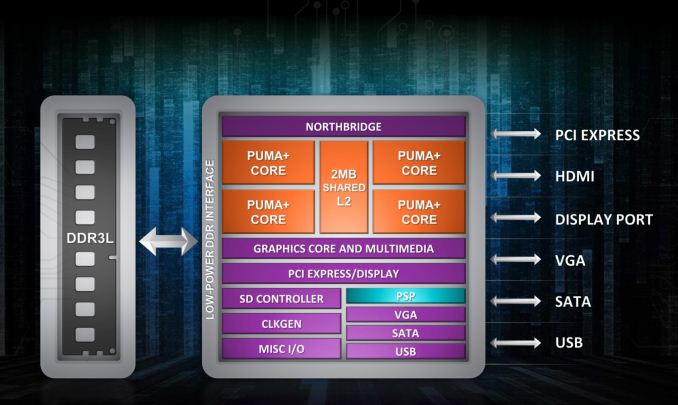AMD Beema/Mullins Architecture & Performance Preview
by Anand Lal Shimpi on April 29, 2014 12:00 AM ESTFinal Words
Despite no significant changes to the architecture or manufacturing process, AMD’s 2014 updates to its entry level and low power silicon are substantial. We finally have AMD silicon, built around a non-Bulldozer architecture, that seem to have turbo capabilities comparable to Intel’s. The result is a completely different performance profile. While AMD’s Jaguar cores in Kabini and Temash were easily outperformed by Intel’s Bay Trail, Puma+ pulls ahead. AMD continues to hold a substantial GPU performance advantage as well.
The gains in performance come while decreasing platform power. You can now have roughly the same performance as AMD offered last year in a 15W entry level notebook part, in a 4.5W TDP (2.8W SDP) tablet SKU. That’s seriously impressive.
The progress AMD made in a year with Beema and Mullins shows just how time constrained the team(s) were with bringing Kabini and Temash to market in 2013. While both of those SoCs were quite successful for AMD, I expect that at some point AMD won’t be allowed two years to fully polish a single design.
The big unknown is how these new SoCs stack up against Bay Trail when it comes to power consumption. From a performance standpoint at the very high end they are faster, but we’ll have to wait until we can get our hands on shipping devices before we know the full story when it comes to battery life. AMD expects to see Beema and Mullins designs show up over the next 1 - 2 quarters, with some designs shipping in the coming weeks to specific regions.
The other thing we need to see is a real Android strategy from AMD. Mullins seems like a good fit for a high performance Android tablet, but today AMD’s native OS strategy is exclusively Windows. I don’t think it’ll stay that way for long, but AMD has yet to give us any indication of when it’ll change.
And if I’m asking for things I want to see from AMD, you can add a PoP package and idle power that’s competitive with the likes of Apple and Qualcomm. AMD clearly came a long way over the past couple of years, but there’s still more progress to be made.











82 Comments
View All Comments
saneblane - Tuesday, April 29, 2014 - link
Unlock That 2.4GHZ Beema Pls. It sure would be nice to get an Amd quadcore 3GHZ at 25 watts.Amd Should increase the highend on these and kill of Low Power Kaveri.
MrHorizontal - Tuesday, April 29, 2014 - link
Interesting little package that.But very little detail on the memory controller - how wide is it? From what I can see it's just single channel. Personally I think these Puma cores would serve AMD a lot better as a low power Opteron CPU than ARM would, equivalent to Intel's Avoton package, provided they can use a significant amount of memory on a system - a single channel won't cut it.
MrSpadge - Tuesday, April 29, 2014 - link
Single channel, since it's I/O compatible with the previous chips.mfoley93 - Wednesday, April 30, 2014 - link
The author should add this, to the article, not everyone that is interested keeps up on this stuff closely enough to remember all of the details from 8 months ago.piroroadkill - Tuesday, April 29, 2014 - link
Makes you once again realise how wimpy the CPU is in the Xbox One and PS4.8 Jaguar cores. More crap is still crap.
These cores are far better than that, and still wouldn't be considered high end.
H2323 - Tuesday, April 29, 2014 - link
8 Jag cores that have access to fast memory are plenty good for a multi-threaded gametipoo - Tuesday, April 29, 2014 - link
Disagreed. It was a matter of performance for cost, and even though each Jaguar core may perform half as well as a high end desktop core, they were able to fit 8 cores into less die space than those bigger cores would have taken. If a developer takes good advantage of multithreading they'll be fine for a while.Antronman - Wednesday, April 30, 2014 - link
But they won't considering most engines used are multiplatform engines and the majority of the games made with those engines are single threaded.The performance sucks, no matter how you look at it.
Graphics have a big effect on performance, and the graphical power on the new consoles is...less than enough.
lmcd - Friday, May 2, 2014 - link
Are you kidding? Engines mean that things can be more threaded as it's more abstracted and so more time can be spent on threading (as opposed to rewrites and higher-level coding that a smaller team would deal with).coburn_c - Tuesday, April 29, 2014 - link
Oh look another AMD product launch with regressive performance... and yet another AMD product launch where their power usage is double that of the competition. Still I suppose it's an improvement, they could be at 4x the power usage now if they hadn't finally done some work. Well I suppose they can just lay off another 25% of the company, that'll sure help close the gap..